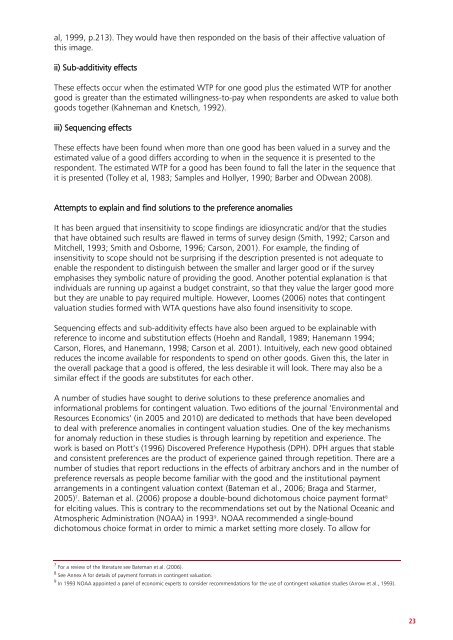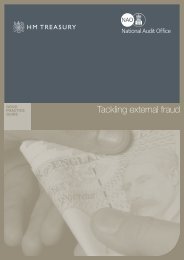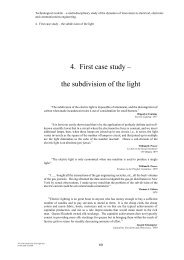Valuation Techniques for Social Cost-Benefit Analysis: - HM Treasury
Valuation Techniques for Social Cost-Benefit Analysis: - HM Treasury
Valuation Techniques for Social Cost-Benefit Analysis: - HM Treasury
You also want an ePaper? Increase the reach of your titles
YUMPU automatically turns print PDFs into web optimized ePapers that Google loves.
al, 1999, p.213). They would have then responded on the basis of their affective valuation of<br />
this image.<br />
ii) Sub-additivity effects<br />
These effects occur when the estimated WTP <strong>for</strong> one good plus the estimated WTP <strong>for</strong> another<br />
good is greater than the estimated willingness-to-pay when respondents are asked to value both<br />
goods together (Kahneman and Knetsch, 1992).<br />
iii) Sequencing effects<br />
These effects have been found when more than one good has been valued in a survey and the<br />
estimated value of a good differs according to when in the sequence it is presented to the<br />
respondent. The estimated WTP <strong>for</strong> a good has been found to fall the later in the sequence that<br />
it is presented (Tolley et al, 1983; Samples and Hollyer, 1990; Barber and ODwean 2008).<br />
Attempts to explain and find solutions to the preference anomalies<br />
It has been argued that insensitivity to scope findings are idiosyncratic and/or that the studies<br />
that have obtained such results are flawed in terms of survey design (Smith, 1992; Carson and<br />
Mitchell, 1993; Smith and Osborne, 1996; Carson, 2001). For example, the finding of<br />
insensitivity to scope should not be surprising if the description presented is not adequate to<br />
enable the respondent to distinguish between the smaller and larger good or if the survey<br />
emphasises they symbolic nature of providing the good. Another potential explanation is that<br />
individuals are running up against a budget constraint, so that they value the larger good more<br />
but they are unable to pay required multiple. However, Loomes (2006) notes that contingent<br />
valuation studies <strong>for</strong>med with WTA questions have also found insensitivity to scope.<br />
Sequencing effects and sub-additivity effects have also been argued to be explainable with<br />
reference to income and substitution effects (Hoehn and Randall, 1989; Hanemann 1994;<br />
Carson, Flores, and Hanemann, 1998; Carson et al. 2001). Intuitively, each new good obtained<br />
reduces the income available <strong>for</strong> respondents to spend on other goods. Given this, the later in<br />
the overall package that a good is offered, the less desirable it will look. There may also be a<br />
similar effect if the goods are substitutes <strong>for</strong> each other.<br />
A number of studies have sought to derive solutions to these preference anomalies and<br />
in<strong>for</strong>mational problems <strong>for</strong> contingent valuation. Two editions of the journal ‗Environmental and<br />
Resources Economics‘ (in 2005 and 2010) are dedicated to methods that have been developed<br />
to deal with preference anomalies in contingent valuation studies. One of the key mechanisms<br />
<strong>for</strong> anomaly reduction in these studies is through learning by repetition and experience. The<br />
work is based on Plott‘s (1996) Discovered Preference Hypothesis (DPH). DPH argues that stable<br />
and consistent preferences are the product of experience gained through repetition. There are a<br />
number of studies that report reductions in the effects of arbitrary anchors and in the number of<br />
preference reversals as people become familiar with the good and the institutional payment<br />
arrangements in a contingent valuation context (Bateman et al., 2006; Braga and Starmer,<br />
2005) 7 . Bateman et al. (2006) propose a double-bound dichotomous choice payment <strong>for</strong>mat 8<br />
<strong>for</strong> elciting values. This is contrary to the recommendations set out by the National Oceanic and<br />
Atmospheric Administration (NOAA) in 1993 9 . NOAA recommended a single-bound<br />
dichotomous choice <strong>for</strong>mat in order to mimic a market setting more closely. To allow <strong>for</strong><br />
7<br />
For a review of the literature see Bateman et al. (2006).<br />
8<br />
See Annex A <strong>for</strong> details of payment <strong>for</strong>mats in contingent valuation.<br />
9<br />
In 1993 NOAA appointed a panel of economic experts to consider recommendations <strong>for</strong> the use of contingent valuation studies (Arrow et al., 1993).<br />
23





![AIRTO [Professor Dr Brian Blunden] - HM Treasury](https://img.yumpu.com/15492848/1/184x260/airto-professor-dr-brian-blunden-hm-treasury.jpg?quality=85)










